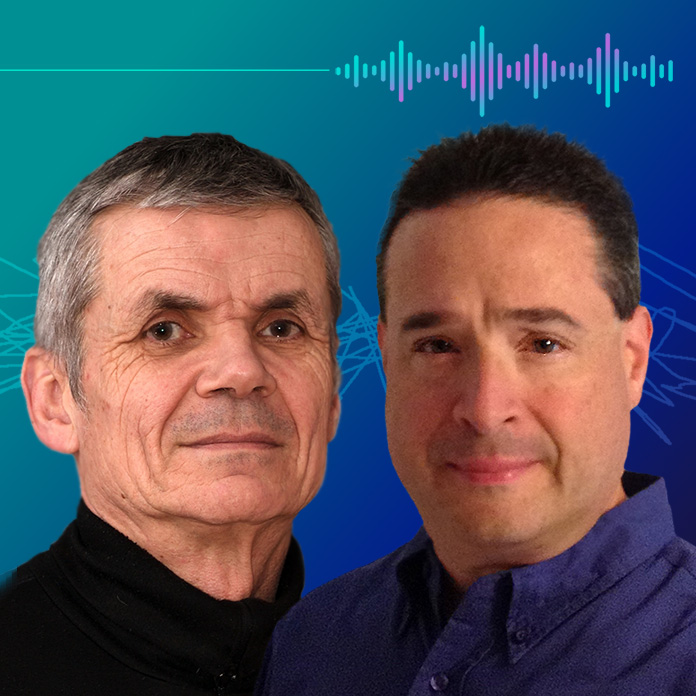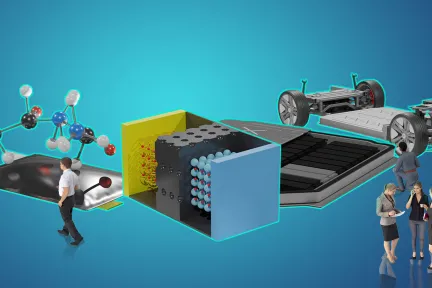#22: How Can You Empower Your High-Tech Engineers?
Discover how seamless collaboration, cloud-enabled apps and effective knowledge re-use accelerate creating innovative high-tech experiences
#22: How Can You Empower Your High-Tech Engineers?
The demand for faster innovation in the High-Tech — with an imperative to achieve more with less — is continuing to increase. In this episode, we look at the real-life value of collaborative engineering and how it can power the development and delivery of high-tech products and systems.
Click here to find out more.
Meet our speakers
When all project participants have real-time visibility into what others are doing, then they get inspired by each other and become more creative than when they work separately.”
Michel Monsellier
Read the transcript
Narrator: Welcome back to Disruptors Unleashed, the series that explores the disruptive technologies shaping our world and the trailblazers igniting change across industries. Previously, we looked at how the virtual twin is transforming healthcare, especially the way medical devices are designed, manufactured and approved.
Today, we'll shift gears and head into the world of high-tech engineering. What does collaboration bring into the development and delivery of high-tech products and systems? Let's find out with Michel Monsellier and Lou Feinstein from Dassault Systèmes.
Host, Neno Horvat: Welcome to our conversation about collaborative high-tech innovation. We all know how incredibly fast-paced this innovation is, with the cloud and AI now providing additional boosts. Today, let's dive into the pivotal role of optimizing people and team efficiency — which is a decisive yet often overlooked lever in the pursuit of high-tech excellence. With me today, we have Michel Monsellier and Lou Feinstein, two of our senior experts for high-tech innovation. Hello, Lou and Michel!
Lou Feinstein: Hi, Neno.
Michel Monsellier: Hello, Neno.
Neno: Lou, you have been in the industry for a few years now, and you’ve been in so many different key roles — from engineering to consulting, sales and strategy. Just to get warm: Any comment to the situation I just mentioned?
Lou: Absolutely! From talking to, and talking with, so many high-tech innovators — and also from continued industry research — we know that the demand for faster innovation with an imperative to achieve more with less – is continuing to increase. Indeed, their life is still getting more complicated every day. I’ll be happy to share with you some ways we can help mitigate this headache.
Neno: Thanks, Lou. And I’m looking forward to what Michel will share with us. Michel, your experience ranges from sales to consulting to product management. How can we and our partners help high-tech companies to square that circle?
Michel: Great question. It’s actually in many ways. To make it simple, we see three levers for our customers to conduct efficiency improvements: First, by enabling smooth collaboration all the way from ideation to product release. Second, by leveraging the right tool-set, and last, by sharing, growing and capitalizing know-how. Most importantly, however, these three levers complement and reinforce each other, creating a lot of synergies.
Neno: So, we see the value in using all three levers simultaneously, right? So, let’s talk about the first lever: Enabling smooth collaboration. Lou, what’s your observations and recommendations?
Lou: Well, first and foremost, going beyond pure data sharing, teams need to have a common or shared “project space." This space becomes what we could consider the digital hub where ideas, tasks, and collaboration can happen seamlessly, no matter where team members are located. Now, when we talk about project spaces, they should be contextual, ensuring that everyone can easily find what they need so they can understand the relationships between various pieces of information. It's about creating an environment that supports the unique needs of each individual project.
Neno: Indeed. Adaptability is key. All teams are different, and so are the people within them.
Lou: Yeah, actually that’s really important. Project spaces should be flexible and adaptable to accommodate these differences. Because one size does not fit all and this can really cause problems to happen, and so every enterprise has diversity. But let's keep in mind the simplicity and intuitiveness. Project spaces should be easy to use, with visual aids like Kanban boards and Agile development or a post-it-style interface, all while being paperless, shareable, and traceable.
Michel: Exactly! The real magic happens when project spaces inspire collaboration. High-performance environments that are easy to navigate and interact with can drive teams to achieve their best. It's about creating an environment where collaboration is natural and inspiring.
Neno: And speaking of inspiration, active collaboration stimulates innovation, right?
Michel: That’s the point! When all project participants have real-time visibility into what others are doing, then they get inspired by each other and become more creative than what they would do when they work separately. It's like a virtual brainstorming session that’s always active.
Neno: So, can we say that creating a shared project space that goes beyond pure data sharing is more than a nice-to-have? Is it actually essential?
Lou: Indeed! It should be contextual, adaptable, simple and easy to use, and most importantly, inspiring for collaboration. Because when teams collaborate effectively, they can achieve amazing results and drive innovation to new heights.
Neno: Sounds good. Here’s another aspect about teaming: How about the ability to focus collaboration on the right things that truly matter?
Michel: That’s so important, indeed! Teams often have to spend too much time and energy in searching for information and data that could be made more easily accessible to them and more traceable. It's about channeling our collaborative efforts towards important, value-added topics, rather than getting lost in administrative tasks and error mitigation.
Neno: OK. Can you give an example?
Michel: Sure! When it comes to early project phases, creativity is paramount. Team members need the freedom to brainstorm and create in a free-flowing spirit. However, it's equally essential to have a transparent structure to capitalize on those creative moments. This structure allows us to revisit previous ideas, concepts or versions, ensuring that all valuable insights are capitalized within the creative process. As projects progress and ideas take shape, then the need for synchronization becomes more apparent. Design feeds into engineering in an iterative journey, and this requires continuous coordination. Then, cross-discipline visibility on project progress fosters a sense of involvement and assurance that everything is under control. It's kind of like having a GPS for your project's journey.
Lou: In all this, let’s not forget that collaboration needs to be real-time, with low latency and with high security in today’s environments. To achieve this, using cloud solutions with an intelligent, high-performance distributed infrastructure is a necessity. In a world where remote work is prevalent, having access to a robust, secure and responsive platform ensures that collaboration is smooth and efficient.
Neno: OK. Great! Now, let’s now move to the second aspect and look at the importance of leveraging the right tools for the right actions at the right time. In today's digital age, tools are the backbone of productivity and innovation.
Lou: Absolutely! I think that, first and foremost, it's important to understand that tools contain knowledge and drive productivity. At the same time, they must evolve with higher, ever-changing requirements of today’s work. Just as technology advances, so should our tools. High-tech teams want to ensure that their tools are interconnected and continuously simplified to prevent the proliferation of disparate systems. This cohesion facilitates seamless collaboration and efficient workflows.
Neno: So, inclusivity is really key when putting advanced tools into the hands of engineers and business professionals.
Michel: Correct! Now, speaking of engineers… beyond design tools for mechanical parts, electronics and software, simulation takes center stage with exploration capacity. In high-tech industries, we see now that comprehensive 360° simulations, including material stress, vibration, thermal, electromagnetic and signal integrity simulations, now really become innovation enablers.
Lou: Indeed! Early-stage simulation is really a game-changer. It allows for the exploration of multiple options in various conditions without the need for costly prototypes. This democratizes simulation expertise and boosts innovation in the early stages of product development.
Michel: The era of physical testing as the main approach is over. To innovate efficiently, we can now use ‘morphable’ virtual twins that offer infinite configuration potential, allowing our customers to explore disruptive solutions that were previously unimaginable.
Neno: I like ‘morphable.’ But tools aren't just for engineers; they're equally important for business professionals like product and project managers, right?
Lou: Often forgotten, indeed! Tools for those roles can help a lot of us to innovate while reducing time to market. Take facilitating tasks like comprehensive market research. Those are no longer manageable manually in today's fast-paced world.
Michel: In high-tech, understanding consumer feedback and competitive landscapes is vital. It helps teams stay focused on what truly matters for customers and consumers, ensuring that time and resources are used efficiently and purposefully.
Lou: For instance, project managers no longer need to chase engineers for status updates and issue reports. With a single source of truth and data intelligence, they have immediate access to relevant information, allowing them to manage projects more efficiently.
Neno: Right! So, it’s obvious that when you combine the use of the right tools with enhanced collaboration among team members, you not only achieve efficiency but also create synergies and mutual reinforcement.
Michel: Correct! It's all about leveraging technology to its highest potential to drive collaborative innovation and efficiencies at the same time.
Neno: Perfect! So, let’s talk about our last lever, which is about sharing, growing and capitalizing on know-how – which is a cornerstone of innovation and success in the high-tech industry.
Lou: Absolutely! Knowledge and know-how are the lifeblood of innovation, and they come in many forms. High-tech companies, regardless of size, grapple with challenges such as an aging workforce, intellectual knowledge sharing and even such mundane things like making knowledge accessible and secure.
Michel: I agree. We see that high-tech innovation thrives on cross-cultural, multi-discipline collaboration. This diversity of perspectives, often coming from different backgrounds and cultures, gives birth to disruptive ideas that transcend individual or peer group thinking.
Lou: Indeed, knowledge is not confined to organizational or functional boundaries. Companies are eager to tap into what we consider tribal knowledge from communities and informal networks, recognizing that valuable insights can emerge from unexpected places.
Michel: Sharing knowledge must be easy and intuitive, deeply embedded in a company's culture. A common platform, enhanced by 3D visualization and contextualized information, is a powerful catalyst for knowledge capitalization and growth.
Neno: How about model-based systems engineering (MBSE) for effective knowledge sharing and accessibility?
Lou: That’s an excellent example! MBSE facilitates solution, architecture, structure, requirement formalization and the streamlining of downstream processes, contributing a lot to the continuous success of projects.
Michel: Another vital example is what we call the ‘front-loading’ of process engineering and manufacturing know-how. Proper product architecture definition and design are essential for leveraging available manufacturing technologies and capacities. In fact, often you can turn this around and realize that good product engineering is actually impossible without the presence of deep manufacturing know-how.
Lou: So true, Michel! In addition, this challenge arises in a globalized value network, especially when working with partners worldwide. Luckily, the cloud emerges as a powerful facilitator for knowledge capitalization, enabling a single, shared and secure environment that transcends corporate and geographical boundaries.
Neno: That’s great. Now, may we conclude that rather than treating IT, processes and know-how separately, companies can embrace a holistic approach?
Michel: Yes, indeed. This approach generates synergies that empower people and ecosystems, driving innovation and efficiency.
Lou: And ultimately, it holds the promise of breakthrough, sustainable innovations that benefit both businesses and the planet.
Neno: Thank you so much, Lou and Michel.
Narrator: Disruptors Unleashed is produced by Dassault Systèmes. For more episodes, follow us on Apple Podcasts, Spotify, Deezer, or your nearest streaming platforms. To learn more about Dassault Systèmes, visit us at 3ds.com.










